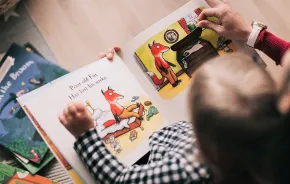 Seattle Children's Theatre's new production, The Edge of Peace, is a richly lyrical, historically interesting, culturally relevant intrigue — as in: mystery — with some good old-fashioned fart jokes worthy of an audience of 10-year-olds.
Seattle Children's Theatre's new production, The Edge of Peace, is a richly lyrical, historically interesting, culturally relevant intrigue — as in: mystery — with some good old-fashioned fart jokes worthy of an audience of 10-year-olds.
Coincidentally, my daughter and her fourth grade classmates went on a field trip to see The Edge of Peace a few days after I saw the play. Though we saw it separately, we had a good time discussing the play at dinner.
It was a complicated conversation, because The Edge of Peace is a complicated play.
There’s a lot of “there” in Ware, Illinois, the small town in which the drama unfolds. It’s a tight-knit community of eclectic characters under the duress of the last days of World War II and an excellent portrayal of life on the homefront with its ration tickets, community air patrols and letters from overseas.
My daughter identified readily with the mischievous Buddy (Nate Kelderman), an 11-year-old conflicted by his boyish love of airplanes, heavy artillery and the excitement of war and his personal loss when his older brother goes missing in action at the Battle of the Bulge. It’s Buddy who sleuths out the mystery in Ware and delivers the best fart jokes.
We bonded over our admiration for Tuc — mailman, mechanic, and the play’s central narrator — who delivers his lines in the physical poetry of American Sign Language. (No need to fret about communication gaps: Tuc’s signing is simultaneously vocalized for the hearing audience by his shadow-voice, who follows him throughout the play.)
 Expertly played by deft deaf actor Robert Schleifer, Tuc has transcended his different-ness to become an integral part of this small-town community. Watch him closely: Mr. Schleifer’s performance is amazingly nuanced — he signs differently to each character and his “tone” captures the essence of each of his relationships. When Tuc gets the opportunity to work in the Goodyear plant in Akron, Ohio, Shleifer dexterously expresses Tuc's personal conflict between his sense of responsibility for his hometown community and his hope for a bright future in the larger deaf community at Goodyear.
Expertly played by deft deaf actor Robert Schleifer, Tuc has transcended his different-ness to become an integral part of this small-town community. Watch him closely: Mr. Schleifer’s performance is amazingly nuanced — he signs differently to each character and his “tone” captures the essence of each of his relationships. When Tuc gets the opportunity to work in the Goodyear plant in Akron, Ohio, Shleifer dexterously expresses Tuc's personal conflict between his sense of responsibility for his hometown community and his hope for a bright future in the larger deaf community at Goodyear.
As much of the play is informed by Tuc’s longtime relationships with Ware’s townsfolk, it may be helpful to note that The Edge of Peace is the capstone of a trilogy by Suzan Zeder.
The dialogue frequently references the back story from the previous two plays, Mother Hicks and The Taste of Sunrise: Tuc’s Story — just enough to make you wish Seattle Chidren's Theatre (SCT) would mount the trilogy in its entirety, but not so much that it disrupts the flow or meaning of this particular play.
[An interesting side note: Seattle Children’s Theatre has had a long-running relationship with playwright and UT professor Zeder and the deaf theater community. SCT mounted Mother Hicks in 1983 and Taste of Sunrise in 1996, and from 1993–2007 supported the Deaf Youth Drama Program. Suffice it to say that The Edge of Peace is an emotionally charged production that in many ways encapsulates decades of creative work and artistic struggle.]
Some wonderfully strong female characters round out the cast. My daughter was captivated by Girl, an adventurous young woman who has blossomed from a Depression-era orphan of a previous play into a pilot for the war effort. Imbued with Amelia Earhart-esque spunk by Alexis Scott, Girl blithely parachutes her way into the story and the imagination of young audience members.
Speaking of parachutes, there is some excellent theater magic in Seattle Children’s Theatre’s production. Floating windows depict houses; the General Store set feels like a tree fort; and the light in the branches of the wooded night is wonderfully spooky. My daughter was enchanted by Delano, the invisible opossum under Mother Hicks’ porch.
It was a joy to experience The Edge of Peace. Seattle Children’s Theatre has once again proved that drama expressly created for children can be serious and sophisticated without losing its playfulness or sense of humor. And, like all good art, The Edge of Peace will provide some interesting dinner conversation with the family.
If you go ...
When and where: The Edge of Peace runs through March 17 at Seattle Children's Theatre's Charlotte Martin Theatre at Seattle Center. Showtimes vary. The March 16 @ 2 p.m. show is ASL-interpreted.
Tickets and info: Tickets are general admission, $29/child, $36/adult; buy online.
Ages: Recommended for ages 10 and up.
Resources: SCT has also done a fantastic job collecting additional educational resources to support The Edge of Peace, including a fabulous study guide with a great recommended reading list for kids ages 10+ put together by Pierce County Librarian Meghan Sullivan.
 About the author: Annie Fanning is a mother of two brilliant daughters, a Seattle Tree Ambassador, and a flower-throwing anarchist. In addition to being a contributing writer, she is also on ParentMap's editorial staff.
About the author: Annie Fanning is a mother of two brilliant daughters, a Seattle Tree Ambassador, and a flower-throwing anarchist. In addition to being a contributing writer, she is also on ParentMap's editorial staff.









